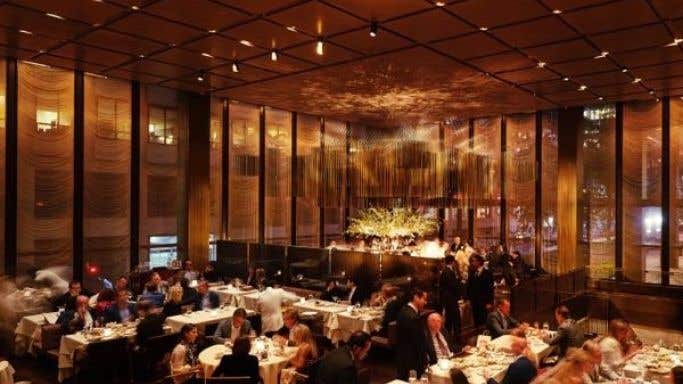A version of this article is published by the Financial Times.
I first came across the cooking talents of Mario Carbone and Rich Torrisi in 2010 when they were poor but obviously talented (see Torrisi night and day).
They had taken over an Italian deli in New York’s SoHo, but in a step that was exciting and dramatic at the time had managed to convert this small place into somewhere that was equally attractive at lunch and dinner.
During the day it served New York style sandwiches. From 4 pm the counter behind was transformed, as was the lighting and the music (I remember Beach Boys and Frank Sinatra), and the pair served a four-course US$50 menu. The phrase Carbone used was that they had decided ‘to chef it out’ – with considerable success.
In the ensuing seven years they have, with their partner Jeff Zalaznick, turned their Major Food Group into one of the city’s major players, opening restaurants that principally reflect their Italian roots: Carbone, Parm and Santina inter alia but also opening Sadelle’s on West Broadway, a modern take on an old style Jewish restaurant that I try to visit whenever I am in town.
The group’s restaurants were located principally too in the ‘cooler’ regions of Lower Manhattan so I was among the many who were surprised, but not shocked, when Major Food Group were announced as the new tenants of what had been for many years the plush surroundings of the Four Seasons Restaurant on E52nd street, the home, perhaps the birthplace, of ‘the power lunch’.
My reaction was such because I knew that the building’s new owners, RFR Holding, wanted to secure a much younger crowd, who would be drawn uptown particularly in the evening. There was little anybody could do with the restaurant’s Philip Johnson interior, which is quite correctly a city landmark, but there was a substantial amount that could be improved in the kitchen.
The Four Seasons name has been dropped and the space carved into two restaurants with The Grill opening five months ago with Carbone in charge. The Pool, with its slightly more relaxed, fishy menu is Torrisi’s domain. The Picasso tapestry in the corridor between the two has been replaced by a modern sculpture bedecked in plants while an Alexander Calder mobile sways gently over the two-foot-deep central pool that gives this restaurant its name.
That Carbone and Torrisi have achieved their first goal of attracting a younger crowd became obvious to me as I took in the Miro and Twombly paintings by the reception. While our friend talked to a mixologist acquaintance, out from behind the receptionist desk came a man sporting a long beard and tattoos on both arms. Brooklyn has moved up town was the obvious message.
Once we had been seated at a corner table in The Grill, the first of the two physical disappointments that follow from the selection of a group led predominantly by chefs became obvious. The music that ranged from Peggy Lee to Mel Tormé was being played far too loudly to allow easy conversation across even our table, far from the noisy bar.
Then with our menus came the second. The ceilings are very high in this restaurant and the American association of dim lighting with sophistication turned what should have been the enjoyment of reading them into something far more closely approaching hard work. The situation was made even worse when our solitary table lamp was withdrawn to make way for the main courses.
The menu here is long. The first page opens with a classic counter of hors d’oeuvres served from a corner station; it takes in a number of more complex first courses and ends with three soups. The second opens with Scottish salmon, lists Dover sole cooked three ways before moving on to several meat courses before finishing with beef off the trolley, served tableside, and then a list of vegetables, potatoes and rice, each cooked five different ways at least.
A great deal of emphasis is put on this style of service, from waiters preparing dishes such as crab Louis and a wild mushroom omelette by your side to using an old fashioned duck press to squeeze out a sauce for a dish they describe as ‘pasta à la presse’, carving the beef as well as preparing an extremely good peach Melba as a dessert. This adds to the buzz but highlighted a particular distinction between the approach of the waiters and that of the waitresses. Only the waitresses seemed to smile and engage.
Of what we ate there were some definite hits: the endive and apple and avocado crab Louis salads made in front of us; their interpretation of a crab cake, where the flesh was topped with a thin layer of crisp potato galette; an elegant Dover sole meunière; and a guinea hen Claibourne (named after the American food writer) served with foie gras.
But there was an obvious heavy-handedness, too. Too much filé, the Southern spice, in the blue crab gumbo; too much salt in the porterhouse steak; not enough acidity or freshness, rather than sweetness, in the desserts.
With two wines (a 2014 Chassagne from Bernard Moreau and a 2012 Bourgogne Rouge from Denis Bachelet) my bill came to US$1,040 for five including service. The overriding impression that I came away with, however, was of a restaurant that five months into its reincarnation is still not yet confident of either itself or what it stands for.
The Grill 99 East 52nd Street, New York; info@thegrillnewyork.com. Closed Saturday lunch and Sunday.

